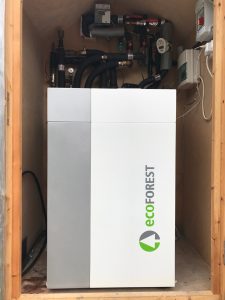
A heat pump collects thermal energy from a cold space and moves it to a warmer one, and if you have a fridge or freezer in your house, you already have a heat pump. Any heat from the cool interior of the fridge is extracted and released through the radiator grill at the back. A small amount of electricity is used to do this, but the amount of electrical energy that you use is less than the amount of energy released as heat. A heat pump can therefore be a very efficient way of providing space heating for a house and it does this by transferring heat from the ground, air or water (such as a stream) to water within a heating system.
A heat pump works most efficiently when it is heating water to around 35°C so it is best suited to heating systems that use quite low temperature water, such as underfloor heating in a well-insulated house.
It is possible to get the water from the heatpump up to 55°C, but the heat pump works less efficiently (you need to use more electricity to get it to this temperature) and if you were using standard radiators, you would need more of them than you would with a standard oil/gas/wood-fired heating system which heats the water up to 70°C.
The following figures, for a typical ground source heat pump system, illustrate the differences in efficiency of heating water to different temperatures:
Water heated to 55° COP = 2.4
Water heated to 45° COP = 3.2
Water heated to 35° COP = 4
(COP – Coefficient of Performance – is the energy efficiency ratio).
For a COP of 2.4, you get only 2.4kW for 1kW electrical input.
For a COP of 4, you get 4 kW of heat for 1kW electrical input.
